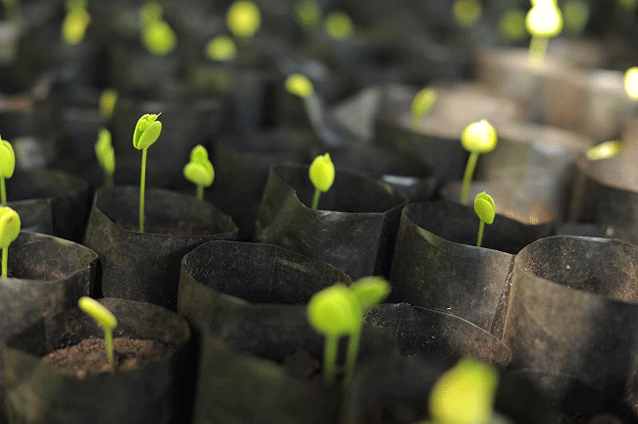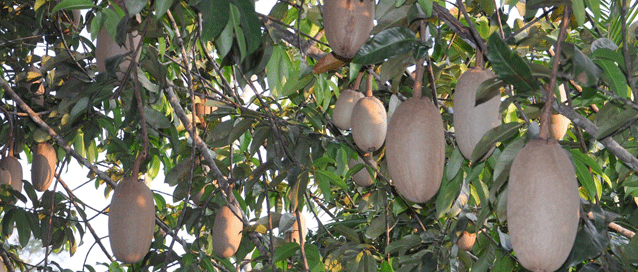Thursday, April 25, 2024
News and Views from the Global South
Food and Agriculture
Poor Orphan Crops…So Valuable, So Neglected

A group of people heading towards Mangoky River (Madagascar) past Baobab trees. Baobab leaves and fruits are sources of food for people and fodder for animals. Credit: FAO/Aris Mihich
- When ‘think-tankers’ in the mid-1990s formulated their famous “think global, act local” slogan, they probably did not expect humankind to require a couple of decades to implement such practical advice.
At least this has been the case for the so-called ‘neglected’, ‘under-utilised’, ‘minor’ or ‘promising’ crops, which have been forgotten over the last century.
Now scientists and policymakers are beginning to recognise the value of these colourfully dubbed ‘orphan’ crops, affirming what local communities have already known for generations.
What Are They?
But what are they all about? The United Nations leading food and agriculture agency provides the answer with some specific examples — the African Yam Bean and the Desert Date, and Ber, a stocky tree with a vitamin-rich berry.
The Food and Agriculture Organization of the United Nations (FAO) explains that the African yam bean, cultivated mainly for home consumption, is planted for its seeds, which are high in protein and low in calories, and are often eaten after being dried and ground into flour or simply boiled and seasoned.
The starch-rich, tuberous roots, similar to spindly sweet potatoes in shape, are consumed either fresh, cut into strips in salads, or dried and ground into flour. The leaves can also be cooked and eaten much in the same way spinach is.
The crop seems to be little affected by altitude, and flourishes at elevations ranging from sea level to 1,800 meters. It takes five to seven months to grow and produce mature seeds.
They appear on a vine growing to between 1.5 and 3 m in height, green in colour or pigmented red. The vines twine clockwise around the stakes or climb around other crops for support; indeed the African yam bean is often used as a living fence. Due to its attractive, large pink and purple flowers, the plant is also cultivated as an ornament.

Moringa seedlings at a nursery in Tanzania. All parts of the Moringa tree are edible. Credit: FAO/Daniel Hayduk
Special Qualities
The UN specialised agency relates some of this crop’s main qualities: typical of legumes, the African yam bean adds a natural nitrogen boost in the soil and reduces the need for fertilizers in areas where it is cultivated; the crop is highly adaptable and capable of growing even on acid and highly leached sandy soils of humid lowland tropics; it is usually intercropped with maize or cassava and also used in crop rotations, and it is mainly used as food for people, but is also used to feed animals.
The point is that the excessively long cooking time (4-6 hours), among other factors, limits the food use of the beans. However, this issue can be overcome using traditional cooking techniques, such as soaking the seeds in water from 4 to 8 hours – a practice that will reduce both the cooking time and the anti-nutrients.
Among others, FAO also explains, some of the nutritional value of the orphan crops are that African yam beans, for instance, have the advantage of producing both beans (pulse or grain) and an edible tuber; the small tuberous roots are white-fleshed, spindly and long like sweet potatoes, but contain more protein than sweet potatoes, cassava or yams, and the dried beans are also rich in protein (18.9 per cent), with a good amount of dietary fibre (16.7 per cent) and 1.5 per cent of fat.
Overlooked by Everybody…
In spite of their high value, they have been overlooked by researchers, extension services and policy makers; governments rarely allocate resources for their promotion and development, FAO underlines. That results in farmers planting them less often, reduced access to high quality seeds, and loss of traditional knowledge.
Why? Simply because these species have been overshadowed by those in greater demand. For example, of the 30,000 edible plant species, a mere 30 are used to feed the world.
“Yet these neglected and under-utilised crops can help to increase the diversification of food production, adding new species to our diets that can result in better supply of particular nutrients, i.e. essential amino acids, fiber, proteins.”
The UN agency also notes that, in addition to diversifying nutritional intake, orphan crops provide economic and environmental benefits–farmers can grow them on their own, as part of crop rotation systems or inter-plant them with other crops, protecting and enhancing agro-biodiversity at the field level.
And having a bigger number of species to choose from in a crop rotation system allows farmers to have a more sustainable production system, it adds. By changing species in a crop rotation system, the cycle of some pests and diseases is disrupted and probabilities of infestations are reduced.
“By expanding the portfolio of crops available to farmers, we can help build more diverse and resilient cropping systems,” FAO Assistant Director-General Ren Wang said.

Allanblackia tree in Kribi, Cameroon. Credit: AfricanOrphan Crops Consortium (AOCC)
In fact, the UN food and agriculture agency, the World Agroforestry Centre (ICRAF), among others, have agreed to work together to strengthen the capacities of FAO member countries and to better focus research and development, plant breeding and seed delivery systems.
Food Security, Nutrition…
“Imagine the positive impacts on food security, nutrition, health, safety and farmers income if crop varieties that rural African families, especially women, grow were more nutritious, higher yielding, and resilient from climate change, drought and pests.”
With these words, FAO announced what it called “an uncommon partnership” of 15 government organisations, scientific, agricultural bodies, universities, companies, regional organisations and NGOs, along with a network of 20 agricultural and horticultural centres, devoted to improving the diets and livelihoods of the 600 million people who live in rural Sub-Saharan Africa, and they believe that this vision will be a reality.
In this partnership, the African Orphan Crops Consortium (AOCC) is the driver to generate the genomic resources for the selected crops. Approved by African Heads of State at the African Union Assembly and led by the New Partnership for Africa’s Development (NEPAD), the AOCC is in fact sequencing the genomes of 101 African food plants.
They Know…
Smallholders and people living in rural areas in Africa grow a huge variety of edible plants other than rice, wheat or maize. These crops, including the African yam bean, have long been neglected although they represent an excellent alternative food supplement to most diets, FAO says.
Grown in pockets of tropical Central, West and East Africa, the African yam bean has great potential to contribute to overall food security and improve local diets. This crop is not to be confused with the other yam bean, the jicama, which comes from Latin America.
The African yam bean is a traditional crop, high in proteins and starch, is highly adaptable to adverse environmental conditions and can fix nitrogen in the soil, which means it does not require a large amount of fertilisers. It is usually grown together with maize or cassava, adds FAO.
In short, scientists and researchers are now discovering what farmers and rural populations have been aware of generation after generation. Better late than never.
-
m&m

 Print
Print



